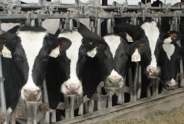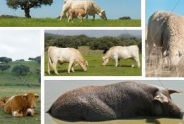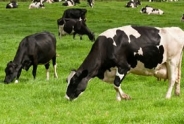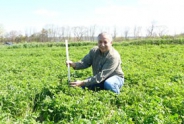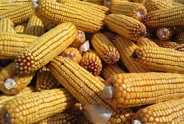First Cutting Updates - Week of May 15th, 2017
Betsy Hicks, Area Dairy Specialist
South Central New York Dairy & Field Crops
May 17, 2017
First Cutting Updates - Utilizing Alfalfa Heights as a Predictor for Quality
The SCNY team is monitoring alfalfa heights again this spring to help predict quality and %NDF for first cutting hay crop. Alfalfa height has been proven to be a reliable indicator of NDF values in the field for alfalfa, alfalfa/grass mixed and all grass stands. Results will be compiled and emailed on a weekly basis - please feel free to forward on. To be included on the weekly email, or to be removed from the email, please contact Betsy Hicks, bjh246@cornell.edu.
UPDATES FOR THE WEEK OF MAY 15th, 2017:
Comments from Janice: Mowing has begun and it's right on for clear grass fields since orchard grass is heading and other grasses will be heading in the next week. Alfalfa is approaching or at 2 ft this week. Only occasional early buds found. With the adequate soil moisture and the predicted heat for the week ahead we have the potential to gain significant yield in the next week to alfalfa. The weather windows and percent alfalfa will drive when to target harvest of mixed stands. The time is near and the switch from corn planting to hay harvest may be necessary to capture high quality. Wet fields will be a factor to consider when planning harvest. In soils that have been saturated or even waterlogged over the last 3 weeks the alfalfa is obviously stressed. It's growing very slowing and in some fields actually going backwards. There are spots of significant winter damage, mainly crown heaving. These fields are going to have a disappointing yield and may be candidates for turning into corn after first cutting.
Comments for Southern Counties (Broome, Tioga, Chemung, S Cortland): Most fields saw a good 3" of growth from last week and are above that 20" mark. Hill ground maybe a bit less, but valley ground a bit more. Several fields of triticale and fields of grass have been mowed already, as well as some fields of mixed alfalfa/grass. Fields continue to be drier here than the northern part of the region (I didn't have to use 4wd to access fields this week!), so I would expect more mixed fields to be knocked down in the coming week. Predicted dates to cut for a 50/50 mix in the southern counties is the end of this week to beginning of next week. Forecast looks like rain Thursday/Friday with a decent weekend, although cooler than the heat we're getting today and tomorrow. Pure alfalfa stands still have some time to gain yield while maintaining quality.
Comments for Northern Counties (Tompkins, N Cortland, Onondaga): Fields saw similar growth to the southern counties in our region - a good 3" overall, hovering around that high teens to low 20's in height. The heat and sun in the next two days will hopefully help to dry out conditions. Predictions for peak quality for a 50/50 mix are looking like this weekend. Don't be fooled by the amount of alfalfa in the stand - often we overestimate the amount in the stand and harvest it later than what the grass's peak quality is. The weekend looks like decent weather, so getting on those mixed fields may be a good idea. We still have time to gain yield in higher percentage alfalfa fields without sacrificing quality. Pure alfalfa stands have time to gain for sure - predictions to cut are still out there to around Memorial Day. The 10-day forecast looks like a small percentage of rain every day, so waiting on the weatherman to figure out his forecast won't hurt quality and will gain tonnage on pure stands in the meanwhile.
Thoughts on pure grass fields that are past peak quality: If you are able to segregate your first cutting, you may want to leave your fields that are past peak quality and save them for dry cow or heifer feed and focus on getting your mixed fields in at peak quality. Certainly, field conditions will play a role, but yield can be a factor to take into account as well.
Please let us know conditions you observe while harvesting, and any comments back about the alfalfa height project are appreciated! We also welcome any sample results you would like to share, so forward them on me, bjh246@cornell.edu. You can also post harvest pictures on our team's Facebook page - https://www.facebook.com/SCNYDairyandFieldCropsTeam/ and use the hashtag #harvest2017.
Additional Information:
The numbers that are indicators for using alfalfa heights for NDF content are as follows:
• 100% grass stands should be cut when nearby alfalfa is 14 inches tall, to achieve 50% NDF
• 50/50 mixed alfalfa/grass stands should be cut when nearby alfalfa is 22 inches tall, to achieve 44% NDF
• 100% alfalfa stands should be cut when alfalfa is 28 inches tall, to achieve 40% NDF
Predicted days to cut are based on daily NDF increases for grasses of 1.0% point, 50/50 mixed alfalfa/grass stands of 0.8% points, and alfalfa of 0.5% points and are adjusted for the coming week's weather. Typically NDF increases about 0.8 to 1.2 per day for grasses, with cooler weather being the lower end of the range and warmer weather being the higher end. For alfalfa, NDF increases about 0.4 to 0.7 per day, also dependent upon warm/cool weather.
The weekly email for the month of May will have a table of the locations around the region where we have measured the alfalfa height, as well as the elevation. Even if your fields aren't measured, you can use the location and elevation as a guide to conditions that may be similar to your own. We now cover six counties throughout South Central NY, including Tioga, Chemung, Broome, Tompkins, Cortland and Onondaga. Other teams and associations throughout the state are also measuring fields. For more information, contact that county's association to find out if fields are being measured there.
Alfalfa Heights - Week of May 15th, 2017 (pdf; 229KB)
Upcoming Events
North American Manure Expo
July 17 - July 18, 2024 : North American Manure Expo
Auburn, NY
Save the Date for the North American Manure Expo
Professionalism in Nutrient Management - www.manureexpo.com
Sundaes on the Farm
July 21, 2024
Spencer, NY
Learn about Tioga County Agriculture! IFree Admission! Enjoy Ice Cream, Animals and Farm Tours, Kid's Activities, Food, Live Music, and Farm Vendors.
Announcements
Farm Participants Needed for Bale Grazing Grant!
Information on the Project:- Approximately 10 acres total needed to bale graze two different bale densities
- "Core" farms will graze two winters, "Demo" farms will graze one winter.
- Payments for both "Core" farms and "Demo" farms
- Baseline soil sampling by bale grazing team
- Forage measurements in early season by bale grazing team
- Late season clipping if residual not trampled down by farm
Interested farms can enroll for this winter or next.
Looking for 2-3 dairy farms to enroll! If interested, please reach out to Betsy Hicks, 607.391.2673 or bjh246@cornell.edu
Cornell Cow Convos - New Podcast
On-going podcast, New episodes released on the last Thursday of the month.Guest speakers, CCE Dairy Specialists.
Housed on Soundcloud Channel is CCE Dairy Educators
Topics:
- Preventative healthcare for cows
- The trend of beef on dairy
- What to look forward to in the new year for dairy
- Socially grouping or pair-housing calves
Dairy Acceleration Program Funds Available
Funds available for the
- organization of financial records/benchmarking up to $1,000
- continued business planning (for farms awarded in a previous year) up to $2,500
- business planning up to $5,000
2018 Drug Residue Prevention Manual
For more than 30 years, the U.S. dairy industry has focused educational efforts on the judicious use of antibiotics through the annual publication of a Best Practices Manual. The 2018 edition of the National Dairy FARM Program: Farmers Assuring Responsible Management? Milk and Dairy Beef Drug Residue Prevention Manual is the primary educational tool for dairy farm managers throughout the country on the judicious and responsible use of antibiotics, including avoidance of drug residues in milk and meat.The manual is a quick resource to review those antibiotics approved for dairy animals and can also be used as an educational tool and resource for farm managers as they develop on-farm best management practices necessary to avoid milk and meat residues. Visit the Manual and Form Library to download copies of this important tool!
Follow us on Facebook
The team updates our facebook page frequently - follow us to be updated on our events, see some fun videos and get local area updates!facebook.com/SCNYDairyandFieldCropsTeam
ProDairy Forage Management
Are you prepared to change your routine this spring?By: Joe Lawrence, Cornell CALS PRO-DAIRY and Ron Kuck, Cornell Cooperative Extension North Country Regional Ag Team
While spring tasks vary by farm, there are many "rites of spring," and they are often completed in a fairly rigid sequence. Depending on the farm, these often include fixing fence, spreading manure, planting new seedings, planting corn and harvesting first cutting, and are often performed in this order.
We are optimistic that the upcoming turn in weather will allow these task to be accomplished in a timely manner, but at this point it is time to ask yourself: Are you willing to change your spring routine?
In addition to adverse weather it is no secret that everyone is facing extremely tight economic times, and dealing with forage inventories of poor digestibility forages from 2017. This combination of factors makes it more critical than ever to be ready to tackle the task that will have the most impact on your business at the proper time.
Recent reference articles on dealing with tough times:
• Key Opportunities to Optimize 2018 Crop Production Efficiency
• Resources for Dealing with Spring Weather Delays
First Cutting
The number one focus should be on timely harvest of first cutting.
• Park the corn planter when a field of first cutting is ready for harvest.
o Monitoring 1st cut harvest timing
• Approach harvest by the acre, not by the field. Be ready to skip over a field that has passed its optimum harvest stage.
o Dynamic Harvest Schedules
• Strategically plan feed storage to best utilize forage inventories for the right group of animals.
o Strategic Forage Storage Planning
o When More is Better
Corn Planting
The window for planting for silage is generally wider than for grain, which is why first cutting can and should take priority over corn planting. However, in the event of extreme delays in planting corn, performance will diminish with late plantings. If corn planting progresses into late May or early June, begin to consider alternative options for those acres. Previous research from Cornell and Penn State suggest a 0.5 to 1 ton/acre per week decline in silage yield for planting after mid to late May.
Multi-Tasking
First and foremost during a time of year that can be very busy and stressful, taking every precaution to keep your team safe is critical.
The idea of fitting all of this work into a condensed time period, and still getting key tasks completed before critical deadlines can seem impossible, but year after year many find unique ways to get it all done. Consider working with neighbors, custom operators or renting equipment to accomplish these key tasks on time.
If you currently utilize custom operators, now is a good time to set up a time to meet with them and make sure you are on the same page to get tasks accomplished in the time-frame needed. Make sure that your expectations and goals are clearly defined. They will also be under stress to fit their work into a condensed period and meet their customers' expectations, so defining expectations and pre-planning how to most efficiently get the work accomplished when the custom operator arrives can go a long way to increase the chances for success.
While spring tasks vary by farm, there are many "rites of spring," and they are often completed in a fairly rigid sequence. Depending on the farm, these often include fixing fence, spreading manure, planting new seedings, planting corn and harvesting first cutting, and are often performed in this order.
We are optimistic that the upcoming turn in weather will allow these task to be accomplished in a timely manner, but at this point it is time to ask yourself: Are you willing to change your spring routine?
In addition to adverse weather it is no secret that everyone is facing extremely tight economic times, and dealing with forage inventories of poor digestibility forages from 2017. This combination of factors makes it more critical than ever to be ready to tackle the task that will have the most impact on your business at the proper time.
Recent reference articles on dealing with tough times:
• Key Opportunities to Optimize 2018 Crop Production Efficiency
• Resources for Dealing with Spring Weather Delays
First Cutting
The number one focus should be on timely harvest of first cutting.
• Park the corn planter when a field of first cutting is ready for harvest.
o Monitoring 1st cut harvest timing
• Approach harvest by the acre, not by the field. Be ready to skip over a field that has passed its optimum harvest stage.
o Dynamic Harvest Schedules
• Strategically plan feed storage to best utilize forage inventories for the right group of animals.
o Strategic Forage Storage Planning
o When More is Better
Corn Planting
The window for planting for silage is generally wider than for grain, which is why first cutting can and should take priority over corn planting. However, in the event of extreme delays in planting corn, performance will diminish with late plantings. If corn planting progresses into late May or early June, begin to consider alternative options for those acres. Previous research from Cornell and Penn State suggest a 0.5 to 1 ton/acre per week decline in silage yield for planting after mid to late May.
Multi-Tasking
First and foremost during a time of year that can be very busy and stressful, taking every precaution to keep your team safe is critical.
The idea of fitting all of this work into a condensed time period, and still getting key tasks completed before critical deadlines can seem impossible, but year after year many find unique ways to get it all done. Consider working with neighbors, custom operators or renting equipment to accomplish these key tasks on time.
If you currently utilize custom operators, now is a good time to set up a time to meet with them and make sure you are on the same page to get tasks accomplished in the time-frame needed. Make sure that your expectations and goals are clearly defined. They will also be under stress to fit their work into a condensed period and meet their customers' expectations, so defining expectations and pre-planning how to most efficiently get the work accomplished when the custom operator arrives can go a long way to increase the chances for success.
NYSERDA Agriculture Energy Audit Program
NYSERDA offers energy audits to help eligible farms and on-farm producers identify ways to save energy and money on utility bills. Reports include recommendations for energy efficiency measures.Eligibility
Eligible farms include but are not limited to dairies, orchards, greenhouses, vegetables, vineyards, grain dryers, and poultry/egg. The farms must also be customers of New York State investor-owned utilities and contribute to the System Benefits Charge (SBC). Please check your farmís current utility bills to see if your farm pays the SBC.
Energy Audit Options
You can request the level of energy audit that best fits your farmís needs. NYSERDA will assign a Flexible Technical Assistance Program Consultant to visit your farm and perform an energy audit at no cost to you.
For more information and the NYSERDA Agriculture Energy Audit Program Application click here
For more information and the NYSERDA Agriculture Energy Audit Program Application click here

